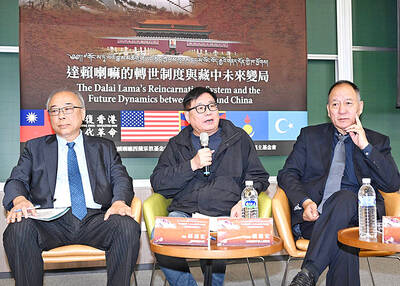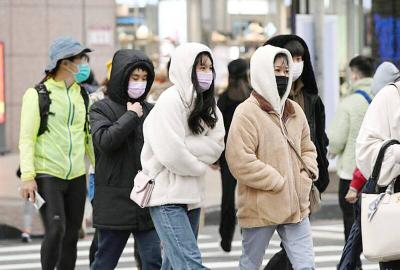Long-term projections have shown that rainfall is likely to decrease in the nation’s southern, central and northern areas and increase in eastern areas, researchers have said.
Liu Chung-ming (柳中明), a professor at National Taiwan University, said these developments were a result of shifting north eastern prevailing winds rather than climate change. However, climate change is likely to exacerbate the situation, creating more anomalies in rainfall patterns and possibly leading to longer droughts, he said.
“Taiwan’s eastern counties are likely to experience an increase in water supply compared with water use, while water supply may become more precarious in other regions, especially the central area,” Liu said.
He said these areas may experience shorter and more concentrated rainfall patterns that will do little to replenish water reserves in the nation’s reservoirs.
“In Tainan County, for example, the previous average for days without rain was 204. In the first 10 months of this year alone, there have been 252 days without rain — the figure is likely to be closer to 300 by the end of December,” Liu said.
In response, officials from Taiwan Water Corp said the company would monitor the situation and acknowledged that shifting weather patterns and climate change could result in longer droughts and more concentrated rainfall.
It would take a two-fold approach to address these changes, first by lowering water use through education and promotion, and then by limiting usage if necessary, the officials said.
Methods used to deal with water shortages range from reducing water pressure at night, placing restrictions on large water users like swimming pools and car washes, and, if necessary, alternating water rationing and stoppages between different areas, the officials said.
An official, who spoke on condition of anonymity because he was not authorized to comment on the matter, said water levels this year have been precarious and the corporation may start limiting water use in central and southern regions starting from the Lunar New Year, depending on levels of water reserves.
Water levels in reservoirs in the Miaoli area in central Taiwan, which are responsible for supplying Tainan and Kaohsiung, are at 50 percent of capacity compared to 84 percent in Shihmen Reservoir in northern Taiwan, the official said. As a result, it is likely there will be water shortages in the areas before the end of the dry season in May.
Officials at the Water Resources Agency (WRA) acknowledged that water shortages may increasingly become a problem in the future, and said that it was working on a series of initiatives to tackle the situation.
“Our data indicates that droughts may become more frequent in future years compared to 60 years ago. Rainfall disparity has risen to 1,500mm annually, from 1,000mm previously,” said WRA spokesman Wu Yueh-si (吳約西), who is also the agency’s deputy director-general, adding that floods and mudslides may become more common.
In recent years, the agency has been busy upgrading reservoirs to deal with increased silt from heavier rainfall and extreme weather such as Typhoon Morakot, Wu said, adding that the agency is also planning to create backup water sources while creating more sustainable water initiatives for towns and villages modeled on similar initiatives found in Japan.
While Wu ruled out large-scale water diversion projects to take advantage of Liu’s forecasts of increased rainfall in the east because of the nation’s mountainous geography, he said the agency was working on smaller initiatives such as a project to divert rainfall from parts of Hsinchu County to the area’s Pao-Shan Reservoir.
However, he said that while the agency has been working on initiatives to create a more stable supply of water in the face of the changing weather patterns, both the public and the agricultural industry should cut down on water use.
Statistics from the agency show that roughly 70 percent of water is used by agriculture and about 10 percent to 15 percent by households.
He added that the government’s policy was to decrease personal water consumption, which has remained steady for the past few years at 274 liters daily, to 250 liters.
The Environmental Quality Protection Foundation agreed with Wu and said that the public needs to start treating water as a precious commodity to stave off future problems.
“The government must increase the promotion and education of sustainable water initiatives ... It also needs to promote the healthy usage of water at home and hope the habits carry into the workplace,” said foundation chairman Hsieh Ying-shih (謝英士) in reference to decreasing industrial and agricultural water usage.
The foundation unveiled the nation’s first personal water calculation system earlier this month, the Taiwan Water Bank (waterbank.tw). Wu said this would show the public their true water usage by taking into account factors such as transportation, food and personal habits.
Users are then encouraged to cut down on their water use, with prizes for those that conserve the most. The sponsor of the program, Coca-Cola, has also pledged to sponsor an elementary school for every 100,000 liters of water saved, with the ultimate target of a reduction of 1 million liters.
“These water problems are going to continue to worsen, [we] need to start acknowledging that water is going to be increasingly important ... and stop taking it for granted,” Hsieh said.

ALIGNED THINKING: Taiwan and Japan have a mutual interest in trade, culture and engineering, and can work together for stability, Cho Jung-tai said Taiwan and Japan are two like-minded countries willing to work together to form a “safety barrier” in the Indo-Pacific region, Premier Cho Jung-tai (卓榮泰) yesterday said at the opening ceremony of the 35th Taiwan-Japan Modern Engineering and Technology Symposium in Taipei. Taiwan and Japan are close geographically and closer emotionally, he added. Citing the overflowing of a barrier lake in the Mataian River (馬太鞍溪) in September, Cho said the submersible water level sensors given by Japan during the disaster helped Taiwan monitor the lake’s water levels more accurately. Japan also provided a lot of vaccines early in the outbreak of the COVID-19 pandemic,

Kaohsiung Mayor Chen Chi-mai (陳其邁) on Monday announced light shows and themed traffic lights to welcome fans of South Korean pop group Twice to the port city. The group is to play Kaohsiung on Saturday as part of its “This Is For” world tour. It would be the group’s first performance in Taiwan since its debut 10 years ago. The all-female group consists of five South Koreans, three Japanese and Tainan’s Chou Tzu-yu (周子瑜), the first Taiwan-born and raised member of a South Korean girl group. To promote the group’s arrival, the city has been holding a series of events, including a pop-up

TEMPORAL/SPIRITUAL: Beijing’s claim that the next Buddhist leader must come from China is a heavy-handed political maneuver that will fall flat-faced, experts said China’s requirement that the Dalai Lama’s reincarnation to be born in China and approved by Beijing has drawn criticism, with experts at a forum in Taipei yesterday saying that if Beijing were to put forth its own Dalai Lama, the person would not be recognized by the Tibetan Buddhist community. The experts made a remarks at the two-day forum hosted by the Tibet Religious Foundation of His Holiness the Dalai Lama titled: “The Snow Land Forum: Finding Common Ground on Tibet.” China says it has the right to determine the Dalai Lama’s reincarnation, as it claims sovereignty over Tibet since ancient times,

Temperatures in some parts of Taiwan are expected to fall sharply to lows of 15°C later this week as seasonal northeasterly winds strengthen, the Central Weather Administration (CWA) said today. It is to be the strongest cold wave to affect northern Taiwan this autumn, while Chiayi County in the southwest and some parts of central Taiwan are likely to also see lower temperatures due to radiational cooling, which occurs under conditions of clear skies, light winds and dry weather, the CWA said. Across Taiwan, temperatures are to fall gradually this week, dropping to 15°C to 16°C in the early hours of Wednesday